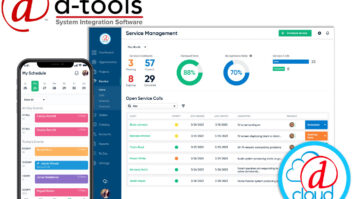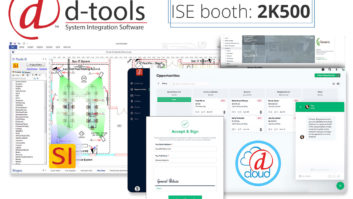Entrepreneur Mark Drax entered the home automation industry in 1996. After working alone for 4 years, he teamed up with a business partner in 2000 and over the last 10 years, has grown Design Logistics UK Ltd (DLUK) significantly.

Mark Drax of DLUK.
At DLUK’s inception, the company was turning over little profitability. Their early projects were relatively small and so they were able to handle typical project documentation such as proposals, purchase orders and invoicing with the combination of software tools Word and Excel. They typically worked on one or two projects at any given time, which didn’t challenge their project equipment and processes too much. However, once the projects started to transition into larger systems, keeping up with the competition became more of a challenge from the perspective of configuring more complicated proposals and the associated project documentation, all of which are often prone to change.
For these larger projects, Drax wanted to ensure that proposals would be consistent from beginning to the end of a project cycle. He found that simultaneous jobs resulted in project life cycles changing much quicker because equipment prices and specifications regularly changed and grew: the variety of customers and products also expanded exponentially and overall project complexity increased ten-fold. In the early days of installing simpler projects, Word & Excel had been sufficient to manage project flow. However, using two separate software solutions exposed significant weaknesses when moving on to much larger integrated installations.
“We went from one extreme to the other almost overnight and now our methods were not factoring in enough project management. We got to a point in business growth where we were dropping balls and making mistakes,” said Drax. “We were missing products because we were just too busy and things were simply being forgotten. We often forgot to increase our labor rate having added more hardware, thereby further cutting our margins. We found that engineering schematics, schedules, system design, purchase orders and managing stock was essential to our business and yet not really feasible with Excel & Word. We needed a solution to help us track the many and varied complications of project management and that’s where D-Tools came in.”
In 2007, Drax and his team implemented D-Tools into the company. They had seen the software in action at many industry tradeshows and believed it offered the necessary functionality they sought to take DLUK to the next level.


D-Tools software enables DLUK to follow products through the entire project cycle through the use of the report generation tools. Previously, DLUK had used only Word & Excel to manage project flow.
“It is imperative to be organized and professional when speaking to a client about the status of their project and you cannot do that without a solid system foundation upon which to rely,” Drax said. “There are a lot of people involved in a project, from installers to electricians to architects and many others and everyone needs to be singing from the same hymn sheet. Keeping everyone informed throughout a project is critical to maintaining project accuracy and we needed a system that could easily generate and distribute all the necessary and appropriate documentation.”
D-Tools software now allows DLUK to follow products through the entire project cycle through the use of the report generation tools. “With D-Tools, we are now able to create many different reports for engineers and our office team, to certify that each phase of the project is streamlined and accounted for. D-Tools has become the most important ‘tool’ in the company and saves us an immense amount of time compared to the convoluted procedures of previous years.”
Drax does note that because D-Tools is a very complex software package, it does take a significant amount of time to accurately set up a robust and accurate database. “You must have a deep understanding of the industry and be able and prepared to put in the time necessary to pour your knowledge into the software to really glean the benefits and fully understand the capabilities and real advantages of D-Tools. We learned the hard way that D-Tools is not a simplistic software solution: we tried to use it without allocating the necessary time and resources to build the foundation database and almost ended up going back to Word & Excel. But we persevered and having finally reached the top of the learning curve, we are now reaping the rewards that come from streamlining so many processes with such a powerful organizational tool.”
“Ironically, it was perhaps the Recession that really made us sit up and focus on what we needed to do to survive. In an easier market, we might well have taken what seemed like the easier option at the time and given up on D-tools, but recognizing the critical need to become more efficient was one of the governing thoughts that helped us accept we had to embrace change and leave behind procedures that would ultimately always come back to haunt us,” Drax said.
“D-Tools has certainly been a major factor in helping us achieve more profitability, efficiency and project visibility. We want to keep learning and becoming even more advanced users, because we find the more we know how to use the software, the more money we make and time we save. Being able to more accurately track our profit margins tells us what we can and cannot afford on each project. This in turn empowers us when it comes to haggling with a client and leaves us knowing just how much we can afford to give away to win a project without it reaching the point of becoming bad business. Ultimately, I feel we win more contracts on the back of being better informed, a process dramatically improved by the implementation of D-Tools.”







